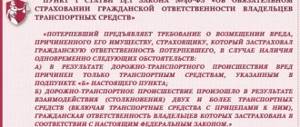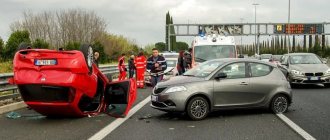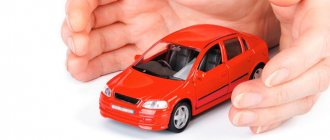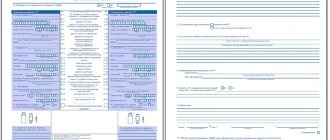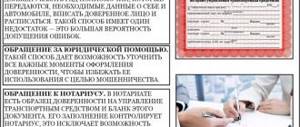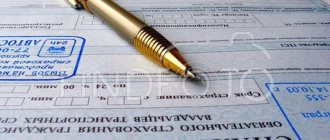OSAGO in case of an accident for an unlimited number of persons
In accordance with paragraph 2 of Art. 15 Federal Law No. 40-FZ “On compulsory civil liability insurance of vehicle owners,” insurance is divided into the following types:
- Limited in number of persons. The policy must name everyone who has the right to use the insured car.
- Unlimited. In this case, anyone can use the machine.
If we are talking about a policy for an unlimited number of persons, the situation is simpler. In this case, having only a driver’s license is enough for the insurer to compensate for losses.
The procedure for the victim in this case should be as follows:
- Call the traffic police and make sure that the employees draw up a report.
- Conduct an independent assessment of the damage. Both the insurer and the person responsible for the accident must be notified about it. In practice, representatives of insurance companies rarely appear for assessments, but it is recommended to follow the procedure.
- Contact the at-fault party's insurance company and file a claim for compensation for the damage.
- Then all you have to do is wait for the payments.
If the insurer does not make payments, the issue can be resolved through court.
Will a power of attorney save you?
No. A power of attorney for a car does not replace the obligation to include the driver in the policy.
However, it may occur. At least, the fact that the power of attorney was canceled a long time ago is not true. It works, they simply abolished the obligation to present it to a traffic police inspector on the road if the driver is not the owner of the car. Why was it cancelled? Yes, because the obligation to be present in the insurance of drivers admitted by the owner is essentially entrusting the first person with the right to drive this car.
OSAGO in case of an accident for a limited number of persons
Dear readers!
Our articles talk about typical ways to resolve legal issues, but each case is unique. If you want to find out how to solve your particular problem, please contact the online consultant form
It's fast and free!
Or call us by phone (24/7):
If you want to find out how to solve your particular problem, call us by phone. It's fast and free!
+7 (495) 980-97-90(ext.589) Moscow,
Moscow region
+8 (812) 449-45-96(ext.928) St. Petersburg,
Leningrad region
+8 (800) 700-99-56 (ext. 590) Regions
(the call is free for all regions of Russia)
However, a policy issued for an unlimited number of persons is rare. And the situation becomes more complicated if we are talking about regular insurance, which clearly indicates the circle of persons allowed to drive.
What else to read:
- My car was scratched in the yard, what should I do?
- Europrotocol 2021
- How to get money instead of repairs under compulsory motor liability insurance: a detailed review
The consequences for a car owner found to be a victim in an accident will vary depending on the situation. There are two options:
- OSAGO is absent altogether.
- There is a policy, but the person driving the car was not included in it.
In the latter case, the actions should be similar to the situation with an unlimited policy. That is, you need to contact the insurer. In accordance with Article 14 of the law on compulsory motor liability insurance, the insurer must still make a payment, but in the future it will recover the amount of payment from the culprit.
In the absence of a policy, the insurer has no obligations to the driver at all. Accordingly, compensation will need to be collected directly from the culprit.
Video on the topic:
What are the consequences if the culprit is not included in the insurance?
If the person at fault for the accident does not have insurance issued to him, then the consequences for him will be as follows:
- He will have to compensate the victim for damages in the amount that is not covered by insurance.
- By way of recourse, he is obliged to compensate the insurer for losses resulting from insurance payments.
- He is held liable in accordance with Part 1 of Art. 12.37 Code of Administrative Offenses of the Russian Federation. This provision provides for punishment in the form of a fine of up to 800 rubles. This is not much, however, until the statute of limitations expires, the guilty party is advised to exercise caution. This is due to the fact that for repeated violations the sanctions will be harsher.
If there is no policy at all, the culprit will not have to deal with the insurance company. However, in accordance with Art. 1064 of the Civil Code of the Russian Federation, damages in full can be recovered from him.
Insurance options
A driver's insurance policy can be of two types:
- The policy specifies all citizens who have the right to drive a car given by the owner of this vehicle. In such a situation, the amount of insurance premiums will be different for everyone, and it depends on some factors, for example, driving experience, accident-free driving experience and the frequency of insured events. If the driver of the car has good indicators described above, then the bonus amount will not be large.
- Open type of policy. When purchasing a policy, no driver data is indicated on it. The owner of the vehicle and any citizen who drives the vehicle with the permission of the owner are insured. This type of policy costs more than a regular policy, however, it has a more extended effect, since it makes it possible to receive compensation even when the guilty person was not included in the policy as a person admitted to management.
The need to take out a policy ensures that in the event of a road incident, the vehicle owner will be able to receive compensation for the damage caused. And not at the expense of the party at fault in the accident, but from the insurer. However, what should you do and what should you expect if the citizen responsible for the accident is not included in the compulsory motor liability insurance?
What are the consequences if an innocent participant in an accident has no insurance?
If a person who is not the culprit of the accident is not included in the policy, then this will not affect the liability of the culprit’s insurance company in any way. However, the victim in such a situation has no choice - he can only file a claim with the insurance company of the person at fault.
Payment or compensation for damages in other ways is carried out in the usual manner. Since the victim has no fault in the incident, the insurer cannot demand compensation from him for expenses. However, a claim for damages may also be refused. But if the culprit has a properly issued policy, the obligation must be fulfilled.
In the absence of fault, a person who does not have a policy and is not the culprit of the accident will also have to pay a fine of 800 rubles. In this case, we are not talking about the absence of paper itself. A violation is the lack of data on the existence of a valid MTPL agreement in a unified information database.
How much does it cost to register a driver?
Sometimes this procedure can be done for free. Changing the number of drivers in the policy does not affect the cost of the contract. If the driver who needs to be included in the compulsory motor liability insurance has lower preferential coefficients compared to those persons who are already on the list, then the procedure for being included in the contract will be free of charge.
We are talking about the following coefficients:
- KBM – bonus malus (granted for driving without accidents);
- by experience and age;
- by the number of violations (described in the Federal Insurance Law).
If the driver who needs to be entered has recently been involved in road accidents, then his KBM coefficient will be large. As a result, to include him in the list of drivers in the MTPL policy, you will have to pay an amount equal to the cost of the contract itself. Therefore, it is necessary to think through and calculate everything in advance.
If the guilt is mutual
In the case of mutual fault, if none of the participants in the accident went to court to establish the degree, its share is distributed equally. So, if there are two private owners, the wine of each will be 50%, three - 33, (3)%.
If one of the participants does not agree with the degree, he can establish it in court. In this case, compensation is proportionate to the share of guilt. For example, if the fault of the first culprit is 30%, and the second – 70%, the insurance company will compensate the first 70%, and the second – 30%, respectively.
If one of the participants in the accident is not included in the compulsory motor liability insurance policy , then in this case there is a recourse to this driver in the share in which his fault is calculated.
Thus, if in the example described above the first driver does not have a policy, 30% of the damage to the other car will be recovered from him. That is, this amount will be equal to the amount that the insurance company will pay or reimburse for repairs.
Is it possible not to include the owner of the car in the policy?
Yes. In car insurance there are generally 4 corresponding terms:
- car owner - the person who owns the car,
- owner - the one to whom the trust right of ownership of the machine (including control) has been transferred or the owner,
- driver - the person driving the car at a given time,
- policyholder - a person who purchases an insurance policy.
So, nowhere in the 2021 legislation does it say that the owner must necessarily be an insured or an approved driver. Moreover, the owner of the car may not have a driver’s license at all, and then it will be physically impossible to include him in the policy.
Damage compensation procedure
Often, adequate drivers who provoked an accident assess the situation realistically and themselves come into contact with the victim, offering him an amicable solution to the issue. However, this does not always happen. If the culprit does not have a compulsory motor liability insurance policy or is not included in it, then the action algorithm for the victim will be as follows:
- The victim must notify the insurance company of the accident.
- The insurer initiates the damage assessment procedure. The driver’s task is to provide the car involved in an accident in proper condition at the specified time and place.
- If there has been any harm to health, you must additionally provide the insurer with medical reports and certificates.
- The amount of payment is determined by the amount of repairs (noted in the inspection report), as well as the amount of compensation for damage caused to health.
- If the driver injured in the accident is not satisfied with the amount of payment, he will file a claim with the insurance company. If there is no action on the part of the latter, the issue can be resolved through the court.
If the person responsible for the accident offers to resolve the issue peacefully, but promises to pay for repairs later, you must do the following:
- Take photographs of the damaged areas of the car.
- Record on video the agreement of the guilty person to compensate for the damage.
- Write down his passport details.
This will help avoid problems if the culprit evades his obligations in the future.
If a person who does not have a policy or is not included in it is a victim of an accident, his position is more attractive than that of the culprit. His rights are insured by law, so in any case he is entitled to compensation for damage to his car and health.
In the event of an accident, you must call the traffic police. Before their arrival, you should not touch anything at the scene of the accident, since the existing traces will be used to draw up a diagram of the accident. It is also recommended to take a photo or video of the accident site and the location of the car.
The traffic police representative must make a note that the victim does not have a policy. It is also necessary that one copy with the passport data of the second party be given to the culprit, and the second to the victim.
The further scheme will be determined by whether the culprit has a policy. If present, the actions should be as follows:
- You must report the accident to the insurance company of the person at fault.
- Wait for the results of the examination.
- If necessary, conduct your own independent examination, notifying the culprit and the insurer about it.
- If the victim does not agree with the amount of material damage determined by the insurer, he must file a pre-trial claim.
- If the insurance company refuses to accept the terms, the victim may go to court.
Regardless of whether the person without the policy is the culprit or the victim, he will have to pay a fine.
What to do if this happens?
When traffic police officers arrive at the scene of an accident and carry out their official duties, it is imperative to check whether they have included information about the absence of a compulsory insurance policy from the person at fault in the accident certificate and protocol.
also be sure to write down information about the culprit of the accident, namely :
- Data from the passport - place of registration and actual residence (if these data differ).
- Information about the vehicle of the guilty person from the STS.
- Contact phone number for communication.
If the guilty person refuses to provide you with the necessary information, then you can take this data from the protocol. A copy of the protocol and a certificate of Form 154 should be given to you by the traffic police officers. After this, an independent examination of the damage to the car should be carried out.
You should not move your car until the traffic police arrive . If this incident occurred on a busy highway, you should first record the position of your car during the accident on a photo or video camera, and only then drive it to the side of the road.
The consequences that can await a driver recognized as a victim in an accident may be different and depend on the specific situation.
Today there are two options for the development of events:
- The owner of the car has a valid auto liability policy, but the specific driver who was driving at the time of the accident is not included in this document.
- There is no auto liability policy or it is expired.
In the first scenario, you should act in exactly the same way as if the culprit had an agreement with an unlimited number of people allowed to drive the car, that is, in this case, the victim contacts the insurance company and actions develop according to the standard scenario.
There is a direct indication of this in the current legislation: Article 14 talks about to whom the insurance organization has the right to put forward recourse claims.
The insurance organization that paid the insurance compensation to the victim transfers the right of the victim to demand compensation from the guilty person in the amount of the amount that the insurance organization paid as compensation if:
- If, when using the car specified in the insurance contract, harm was caused to another person, and the driver who was driving did not have the right to drive this vehicle.
- The guilty person is not recorded in the compulsory insurance contract as a person entitled to drive this car (if a limited insurance agreement was concluded between the insurance company and the owner of the car indicating those persons who are allowed to drive this car).
- The accident occurred during a period when insurance coverage under the contract was not valid (that is, an agreement was concluded under which insurance coverage was valid only for a certain period).
In simple terms, it does not matter at all whether the driver who was driving at the time of the accident is listed in the policy or not ; the insurance company, in the presence of this insurance contract, is obliged to compensate the victim for the damage caused to him. After the insurer makes a payment to the victim, it can recover the expenses it incurred from the at-fault party.
The situation is much more complicated if the compulsory insurance contract for the person responsible for the accident has not been drawn up at all. In this case, the insurance organization is not responsible for the culprit, and therefore the obligation to compensate for the damage caused falls entirely on the shoulders of the culprit himself.
Recourse from the culprit of an accident under compulsory motor liability insurance
The law on compulsory motor liability insurance provides for the institution of recourse. In accordance with it, the person who compensated the victim for the harm for the culprit (the insurance company) has the right to make a return claim against him. Recourse by an insurance company means an exchange of obligations between the insurer and the debtor who caused the damage. By way of recourse, the insurance company may demand compensation for the payments provided to the victim.
The insurer can issue a recourse within three years. This period begins from the date when the insurance company learns about the existence of recourse from it, that is, from the moment of compensation for damage. In practice, the procedure for claiming recourse is as follows:
- An accident occurs, one of the participants in which is not included in the insurance policy and was found guilty.
- Participants document the accident themselves by filling out a European report, or with the involvement of traffic police officers.
- The victim applies for compensation.
- The insurer compensates him for damage caused by a person not included in the policy.
- After a certain time, the culprit receives a letter at the registration address. It specifies a pre-trial requirement to voluntarily reimburse the insurer a certain amount based on Part 1 of Art. 14 Federal Law “On Compulsory Motor Liability Insurance”.
- The recipient can compensate for the damage voluntarily or through the court.
When going to court, expenses in the form of lawyer fees, state fees and small postage expenses are borne by the offender.
The absence of information about the culprit of the accident in the policy does not deprive the victim of the right to receive compensation. In any case, you must contact the insurer and demand compensation for damage.
Is it possible to issue a European protocol?
Yes. In such an incident, you can even register using the European protocol. An unregistered driver is not a condition under which filling out a notice is impossible.
And again “proof”! This time, let's look at Article 11.1 of the Federal Law on Compulsory Motor Liability Insurance. Here in the first paragraph we see the conditions for the possibility of drawing up a European protocol:
- as a result of the accident, only cars were damaged (there were no injured participants in the accident),
- There are only two people involved in the accident,
- there was direct contact between the machines,
- both have valid MTPL policies,
- the culprit and the victim have no disagreements regarding the circumstances of the accident and the damage, and they are reflected in the European protocol.

